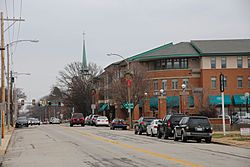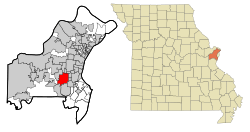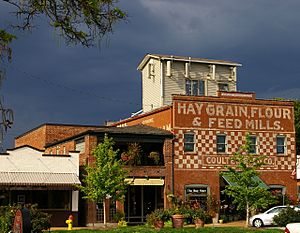Kirkwood, Missouri facts for kids
Quick facts for kids
Kirkwood
|
|
|---|---|
| City of Kirkwood | |

Downtown Kirkwood in December 2014
|
|

Location of Kirkwood, Missouri
|
|
| Country | United States |
| State | Missouri |
| County | St. Louis |
| Incorporated | 1865, 1899 (as a 4th-class city), 1930 (as a 3rd-class city), 1984 (as a home rule city) |
| Area | |
| • Total | 9.21 sq mi (23.84 km2) |
| • Land | 9.18 sq mi (23.78 km2) |
| • Water | 0.02 sq mi (0.06 km2) |
| Elevation | 584 ft (178 m) |
| Population
(2020)
|
|
| • Total | 29,461 |
| • Density | 3,208.56/sq mi (1,238.78/km2) |
| Time zone | UTC−6 (Central (CST)) |
| • Summer (DST) | UTC−5 (CDT) |
| FIPS code | 29-39044 |
| GNIS feature ID | 2395549 |
| Website | www.kirkwoodmo.org |
Kirkwood is a city in St. Louis County, Missouri, located just west of St. Louis. It is known as an "inner-ring" suburb, meaning it's one of the older communities close to a big city. In 2020, about 29,461 people lived there.
Kirkwood was founded in 1853. It was named after James P. Kirkwood, who was the chief engineer for the Pacific Railroad. This city was special because it was the first planned suburb built west of the Mississippi River.
Contents
History of Kirkwood
Plans for Kirkwood started after a big fire in St. Louis in 1849 and several cholera outbreaks. These events caused many deaths in downtown St. Louis. People wanted a new, healthier community nearby.
In 1850, two men, Hiram W. Leffingwell and Richard Smith Elliott, bought land about 14 miles (23 km) from downtown St. Louis. Around the same time, James P. Kirkwood was planning the route for the Missouri Pacific Railroad through this area.
The city of Kirkwood was officially planned in 1852. It was named in honor of the chief engineer, James P. Kirkwood. When the railroad line reached the community in 1853, the land developers started selling plots of land. Kirkwood became the very first planned suburb outside of St. Louis city limits.
In 1866, Quinette Cemetery was established in Kirkwood. It is one of the five historic African American burial grounds in the St. Louis area.
Traditions and Fun Places
Kirkwood has many traditions and interesting places to visit.
Greentree Festival
The Greentree Festival is a big event held every September for three days. It features arts and crafts, delicious foods from different cultures, and lots of fun activities for kids. This festival has been a tradition for over 50 years. Since 1961, it has taken place in Kirkwood Park and includes a parade and a fair. The festival originally started to help replace trees in the park that had been damaged by a drought.
Turkey Day Game
High school football fans in Kirkwood look forward to the annual Kirkwood–Webster Groves Turkey Day Game. This is a long-standing rivalry between the Kirkwood High School Pioneers and the Webster Groves Statesmen. It's the longest-running high school Thanksgiving Day football rivalry west of the Mississippi River. The 100th game was played in 2007. The winning team gets to keep the Frisco Bell, while the losing team receives the Little Brown Jug.
Kirkwood Train Station
The Kirkwood Station is a beautiful train station built in 1893. It has a special architectural style called Richardsonian Romanesque. This station is listed on the National Register of Historic Places (NRHP) and is a symbol of the town. It's the only stop that Amtrak trains make in the St. Louis area outside of the main city.
National Museum of Transportation
The National Museum of Transportation is a private museum in Kirkwood that covers 42 acres. It was founded in 1944. This museum works to restore, preserve, and display many different types of vehicles. You can see cars, boats, aircraft, and especially old locomotives and railroad equipment from the past 150 years of American history.
Kirkwood Farmers' Market
The Kirkwood Farmers' Market started in 1976. It's an outdoor market where you can find a variety of fresh, homegrown vegetables and fruits. More than 300 local businesses contribute to this market.
The Magic House
The Magic House, St. Louis Children's Museum in Kirkwood is a very popular place for families. It opened in 1979 and welcomes over 500,000 visitors each year. More than 10 million people have visited it since it opened! The original building for the museum was built in 1901 and has been updated and expanded many times. The Magic House was even ranked as America's top travel spot for kids by Zagat.
City Awards
Kirkwood has won several awards for its efforts in keeping the city green and beautiful. It received the Arbor Day Growth Award in 1993, 1997, 2003, and 2004. The city also won the America in Bloom 2007 Community Involvement Criteria Award.
Geography
Kirkwood covers a total area of about 9.20 square miles (23.84 square kilometers). Most of this area is land, with a small amount of water.
Population Information
| Historical population | |||
|---|---|---|---|
| Census | Pop. | %± | |
| 1880 | 1,280 | — | |
| 1890 | 1,777 | 38.8% | |
| 1900 | 2,825 | 59.0% | |
| 1910 | 4,171 | 47.6% | |
| 1920 | 4,422 | 6.0% | |
| 1930 | 9,169 | 107.3% | |
| 1940 | 12,132 | 32.3% | |
| 1950 | 18,640 | 53.6% | |
| 1960 | 29,421 | 57.8% | |
| 1970 | 31,679 | 7.7% | |
| 1980 | 27,739 | −12.4% | |
| 1990 | 27,291 | −1.6% | |
| 2000 | 27,324 | 0.1% | |
| 2010 | 27,540 | 0.8% | |
| 2020 | 29,461 | 7.0% | |
| U.S. Decennial Census | |||
2020 Census
The 2020 United States census counted 29,461 people living in Kirkwood. There were 11,423 households, which are groups of people living together. The population density was about 3,209 people per square mile (1,239 per square kilometer).
Most of the people in Kirkwood were white (86.07%). About 5.68% were black or African-American, and 1.55% were Asian. People of Hispanic or Latino background made up about 2.7% of the population.
The average age in Kirkwood was 42.0 years. About 24.2% of the population was under 18 years old.
Getting Around Kirkwood (Transportation)
Kirkwood has several ways to get around, including trains, buses, and major roads.
Trains
Kirkwood is located along the Union Pacific Railroad line. You can catch a passenger train here through Amtrak. The Kirkwood Station is in the center of downtown Kirkwood. It is a stop for Amtrak's Missouri River Runner train.
Buses
Bus service in Kirkwood is provided by MetroBus. These buses connect Kirkwood to other nearby communities and to downtown St. Louis.
Roads
Several important roads pass through or near Kirkwood. Interstate Highway 270 runs along the western edge of the city. Interstate 44 goes through the southern part of Kirkwood. Other main roads include Manchester Road to the north and US 61/67 (Lindbergh Boulevard), which runs north and south through downtown Kirkwood.
Education
Kirkwood has a strong focus on education, with public and private schools, a college, and a library.
Schools for Kids
Public schools in Kirkwood are part of the Kirkwood R-7 School District. This district serves all of Kirkwood and parts of nearby towns like Des Peres and Glendale.
The district has five elementary schools: Tillman, North Glendale, Keysor, Robinson, and Westchester. There are also two middle schools: Nipher Middle School and North Kirkwood Middle School. Finally, there is one high school, Kirkwood High School. After elementary school, students go to either Nipher or North Kirkwood Middle School, depending on which elementary school they attended.
There is also a private Catholic school in Kirkwood called St. John Vianney High School.
Colleges
St. Louis Community College (STLCC) has a large campus in Kirkwood called STLCC-Meramec. It covers 78 acres and is the biggest community college in Missouri, with over 12,000 students.
Public Library
Kirkwood has its own public library, the Kirkwood Public Library, where people can borrow books and other materials.
Religious Organizations
Kirkwood is home to the world headquarters of the Lutheran Church–Missouri Synod. This is a large Lutheran church group with almost 2 million members.
Famous People from Kirkwood
Many notable people have connections to Kirkwood, including:
- Scott Bakula, actor
- Mel Bay, author and musician
- Joe Boever, baseball player (MLB pitcher)
- Alan Bovik, engineering professor who won an Emmy
- Dylan Brady, musician
- Benjamin Gratz Brown, U.S. Senator and former Governor of Missouri
- Jack Buechner, former U.S. Representative
- Edgar W. Denison, naturalist and author
- Nikki Glaser, comedian
- Trent Green, football player (NFL)
- Geoffrey C. Hazard Jr., law professor
- Cactus Keck, baseball player (MLB) and Kirkwood Fire Chief
- Spike Kohlbecker, racing driver
- Jeremy Maclin, football player (NFL)
- Claire McCaskill, political analyst and former U.S. Senator
- Marianne Moore, famous poet and writer
- Bill Pleis, baseball player (MLB)
- Rodger O. Riney, business executive
- David Sanborn, musician
- Dorsey Schroeder, racing driver
- Slayyyter, singer
- Al Smith, baseball player (MLB)
- Rick Stream, former Missouri state representative
- Brandon Williams, football player (NFL)
- Kyren Williams, football player (NFL)
- Mike Wood, football player (NFL)
See also
 In Spanish: Kirkwood (Misuri) para niños
In Spanish: Kirkwood (Misuri) para niños



